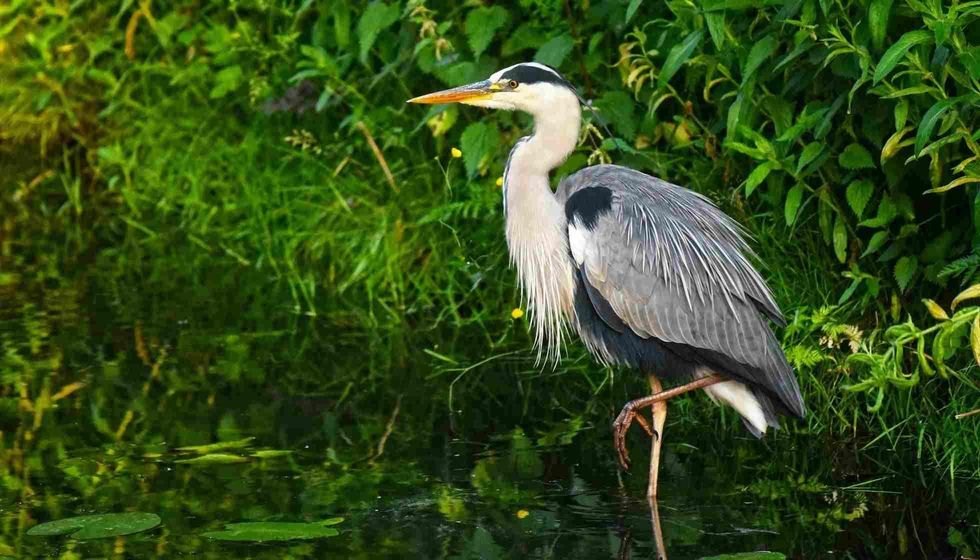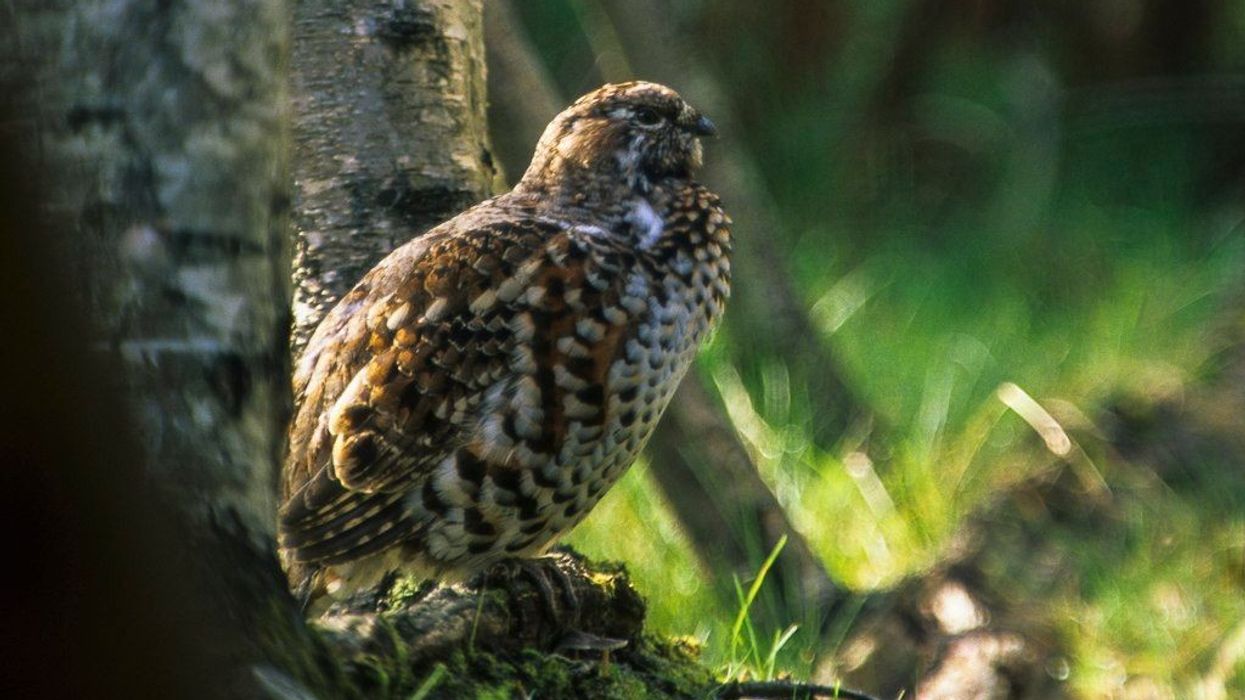Are you inquisitive about birds? Then these grey heron bird facts are just for you!
The grey heron (Ardea cinerea), or gray heron, is a wading bird belonging to the family of herons (Ardeidae). With their tall legs, a long bill, and black, white, and gray plumage, these birds are quite distinctive in their natural habitat which mainly comprises wetlands.
The grey-headed heron may also be seen nesting colonially in tall trees. The grey heron species is a predatory bird and mostly feeds on fish, but their diet may comprise other small animals as well.
The population of grey herons has an extensive geographic range spanning Africa, Europe, and Asia. Often seen standing quietly by water bodies with their long necks stretched out in search of food, the grey herons can fly too, with their necks retracted into an S-shaped bulge.
In fact, a grey heron in flight circling high up in the sky might easily be mistaken for just another predatory bird!
In the grey heron vs. great blue heron debate, people often get confused between the two birds. However, there is a subtle but significant difference between the two birds that makes the grey heron vs. blue heron discussion worthwhile; while the grey heron's cap is medium to dark gray, the North American blue heron has extensive black caps.
Besides, the blue heron is a different species (Ardea herodias) from the grey heron (Ardea cinerea).
Find the grey heron birds interesting? Then read on to learn about the grey heron behavior, habitat, breeding, grey heron size, and more! Check out fun animal facts about shrike and killdeer too.
Grey Heron Interesting Facts
What type of animal is a grey heron?
The grey heron (Ardea cinerea) is a species of predatory heron of the family Ardeidae.
What class of animal does a grey heron belong to?
Grey herons belong to the class Aves which includes all birds.
How many grey herons are there in the world?
According to the data from the International Union for Conservation of Nature (IUCN), 2019, the global population of grey herons stands at 500,000-2,500,000 mature individuals.
Where does a grey heron live?
The population of grey herons is distributed across the tropical and temperate regions of Africa, Europe, and Asia. Outside their natural range, grey herons have also been found in Australia, North America, and Greenland.
The birds require at least four months of warm climate during the breeding season and for the development of the young birds. Besides, the habitat must have a shallow body of water for the birds' feeding needs.
For roosting and nesting, the grey herons prefer the branches of tall trees. If the habitat lacks trees, the grey heron nest may be found in dense undergrowth or bushes.
What is a grey heron's habitat?
Most populations of grey herons inhabit wetlands that include tidal flats, marshes, ditches, small ponds, and wet fields. Wherever these birds live, there is usually a nearby source of water that can be a pond, a river, a lake, coastal lagoons, floodplains, or even estuaries.
The birds may also be found in aquacultures used for the purpose of fish farming, and their terrestrial habitats include forests, savannahs, and grasslands, where they nest on tall trees.
Who do grey herons live with?
In general, the grey heron is a solitary bird that spends most of its time alone, wading in water or feeding in the wetland. However, these birds form typical breeding colonies called heronries atop tall trees and become quite the social animals when nesting in the colony.
How long does a grey heron live?
In the wild, the average grey heron lifespan is about five years. It is quite challenging for a grey heron juvenile to pull through their first winter, but if they do, the juvenile grey heron can live up to almost five years.
How do they reproduce?
The breeding season of grey herons extends from late February to early June. The breeding season is an annual occurrence, happening once a year.
During the breeding season, the adult male chooses a nesting site and gives out a typical grey heron call to attract potential female partners.
Several females may approach the breeding nest of a single male, but the latter chases away females if it is not interested in them. However, grey herons are unique in that both the males and the females engage in consensual pairing and mating.
Once a male-female mating pair forms, an elaborate display of courtship is followed by copulation. After breeding, female adults lay about three to five eggs per season over a period of two days.
The incubation period lasts for around 25-26 days, after which the eggs hatch and the chicks emerge. The chicks, during the early days of development, compete for food and may even push each other off the nest.
It takes about 9-10 weeks for the chicks to become independent, with an average fledging age of 50 days. It takes about a year for the young birds to reach sexual maturity, and they are ready for mating by the next breeding season. Both the male and the female parents contribute equally to feeding and upbringing of the young.
What is their conservation status?
According to the International Union for Conservation of Nature (IUCN) Red List of Threatened Species, the grey herons are of Least Concern. This means that the population of these herons is quite abundant and is in no danger of becoming extinct in the near future.
Grey Heron Fun Facts
What do grey herons look like?
Grey herons are pretty large in size and are mostly covered in grey feathers. All grey heron adults have a white head and neck.
Its eye is above the base of a band of black elongated feathers that rises to the unique black crest on its head. The front of the slender neck is marked by bluish-black streaks of feathers.
The flight feathers are dark gray to black and in sharp contrast with the paler, whitish, or grayish feathers on the rest of the body. A young grey heron typically has dull-colored plumage, and its head and neck are mostly gray with a dark gray crest.
Grey herons have yellow bills all year round, but during the breeding season they take on an orange tinge. The legs of grey herons are very long and brown, and remain extended behind the birds during flight.
How cute are they?
Grey herons cannot really be called cute. However, they definitely look beautiful and elegant with their sophisticated gray and black plumage and long, slender legs.
How do they communicate?
Grey herons are particularly loud herons and have a variety of calls for communication. Their primary call is a loud 'fraaank' call, which is basically a flight call.
The 'gogogo' call expresses alarm or anxiety when a predator is nearby, and the 'oooo' call is a sign of aggression that assumes a gurgling tone when given out during courtship.
The breeding colonies are especially noisy with a range of different sounds and calls emanated by the herons, including squawks, yelps, and other softer tones.
The males have a typical advertisement call to lure the female into the nest, and once a pair has been established, both members of a pair use a variety of greeting calls and gestures such as bill clappering and bill snapping. The chicks make ticking or loud chattering noises.
How big is a grey heron?
The grey heron stands about .3 ft (1 m) tall and measures 33.1–40.2 in (84–102 cm) in length. The size of the grey heron is comparable to that of the blue herons and may as well be called the great grey heron!
How fast can a grey heron fly?
Great herons can fly at about 20-30 mph (32.2-48.3 kph).
How much does a grey heron weigh?
The bodyweight of grey herons can range between 2.2–4.4 lb (1–2 kg).
What are their male and female names of the species?
Male and female grey herons do not have any distinct names.
What would you call a baby grey heron?
A baby heron is mostly referred to as a hatchling or juvenile.
What do they eat?
The grey heron diet primarily consists of fish. However, these birds also prey and feed on other animals such as crustaceans, insects, small mammals, frogs, ducklings, and water rails.
The grey herons feed on prey by devouring them in a single gulp. Sometimes, grey herons may stand in the water on one foot for hours, waiting for potential prey to approach. At other times, these birds may be seen standing in fields for extended periods of time, not hunting but digesting the massive prey that they consume.
Are they aggressive?
Grey herons are solitary creatures that will shy away or feel threatened at the sight of humans. However, they may attack if harassed or provoked.
They are not very social, except during the breeding season, and are not known to interact with birds of other species. If threatened, grey herons raise their crest and display a characteristic stabbing movement with their head.
Would they make a good pet?
Given that the grey herons are not very social creatures, they will not make a good pet.
Did you know...
An adult male and female grey heron pair is monogamous and stays together throughout the breeding season.
The irises of the grey herons are yellow.
While cranes fly with their heads extended, grey herons have their head pulled back towards the body during flight.
Grey herons nest early, evident from their breeding season which begins in early February.
Many birds of the heron family are also known as shitepokes because these birds tend to defecate when they are flushed.
The grey herons are a common sight all over Europe, and especially in the UK.
Grey herons feed on pond fishes and can be a nuisance. Some ways to evade them are proper netting around the pond, growing tall plants on the edges of ponds to block the heron's view, and keeping the water level significantly below the bank.
In the United States, it is illegal to shoot the grey heron or any other kind of heron without a permit from the United States Fish and Wildlife Service (USFWS).
The grey heron symbolism is quite evident in ancient human culture. For example, the ancient Romans considered the heron's call to be an indication of a coming event.
How big is a grey heron's wingspan?
A grey heron's wingspan is about 61–77 in (154.9-195.6 cm).
What were grey herons used for in medieval times?
The grey herons were the preferred quarry of falconers during medieval times. These birds were known for skillfully dodging the stoops of the falcon and were highly regarded for their excellent flying skills. Besides, roasted grey heron meat was a popular delicacy in medieval banquets.
Here at Kidadl, we have carefully created lots of interesting family-friendly animal facts for everyone to discover! Learn more about some other birds including house wren, or hyacinth macaw.
You can even occupy yourself at home by drawing one on our heron coloring pages.










